7 Ways to Tell If You Need a New Roof
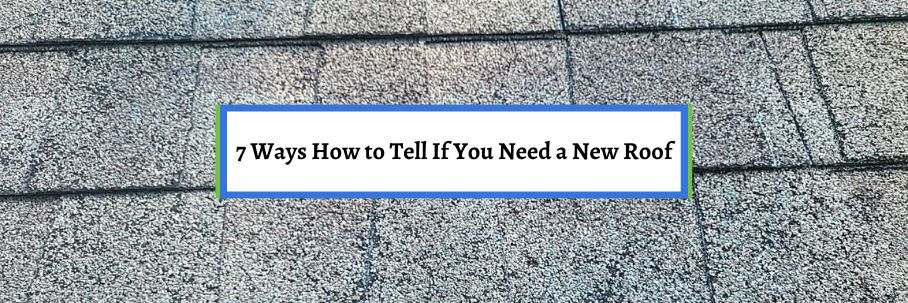
7 Ways to Tell If You Need a New Roof
The ways to tell if you need a new roof are:
- Your roof continuously leaks
- The shingles on your roof are cracked or curled
- There’s loose granules in your gutters or around downspouts
- You see greenery growing on your roof
- There are dark spots on the bottom of your decking
- A storm damaged your roof
- Your neighbors are getting new roofs
Let’s be honest; no one wants to replace their roof. It’s an expensive investment that you technically don’t get to use.
But the roof is your home’s first line of defense from the elements. So, while it’s not a fun home improvement project, it's necessary to protect you, your family, and your valuables.
Unfortunately, most homeowners don’t know they need a new roof until it’s too late and there’s damage. But did you know that your roof actually “tells” you that it needs to be replaced?
For over 30 years, the team at Bill Ragan Roofing has provided transparent and honest roofing advice to homeowners like you. That’s why I’ll break down the ways to tell if it’s time for a replacement.
This article covers the following ways to tell if you need a new roof:
- Your roof continuously leaks
- The shingles on your roof are cracked or curled
- There’s loose granules in your gutters or around downspouts
- You see greenery growing on your roof
- There are dark spots on the bottom of your decking
- A storm damaged your roof
- Your neighbors are getting new roofs
1. Your roof continuously leaks
The first way to tell if you need a new roof is when you have continuous leaks; this is especially true on older roofs. You don’t need a new roof if leaks are caused by something as simple as nail pops or a cracked pipe boot.
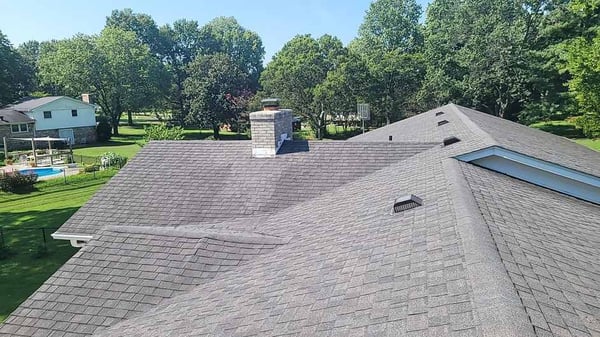
Usually, you won’t know if your roof leak requires repairs or a replacement until after a roof inspection. However, your roof is improperly installed or has reached its maximum lifespan if you're experiencing continuous leaks.
There are situations where a leak is hard to find and repair, so it’s possible that the continuous leak could be from the same problem. That’s why it’s a good idea to get multiple opinions to truly determine if it’s worth getting a new roof.
But there’s a good chance you’ll need a new roof if your current one has continuous leaks and is 15 years old or older.
2. The shingles on your roof are cracked or curled
The next way to tell if you need a new roof is by checking the conditions of your shingles. If you see curling and/or cracked shingles, it’s a clear sign that your roof has reached the end of its lifespan.
.png?width=600&height=338&name=BlogPictures%20(3).png)
Once your shingles show signs of curling and cracking, there’s nothing left to do but get a new roof. Unfortunately, you probably can’t spot this sign without getting on a ladder or fully on the roof.
However, there’s no reason to risk your safety if you don’t have ladder experience or feel 100% confident on one.
3. There’s loose granules in your gutters or around downspouts
Granules are pieces of asphalt embedded in shingles for fire resistance, color, and UV ray protection that are crucial to the longevity of an asphalt roof. Once shingles start losing granules, it’s time for a new roof.
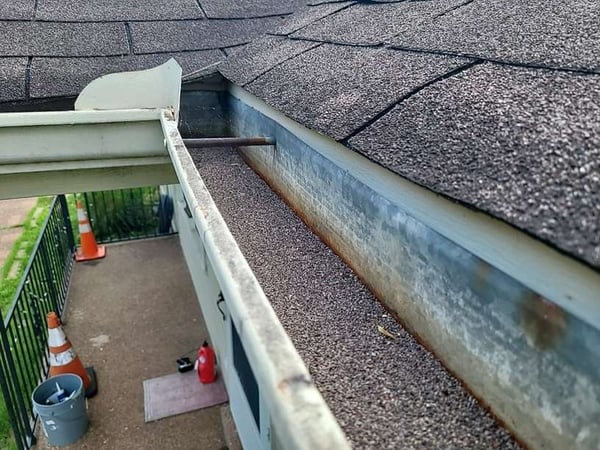
The way to tell if you need a new roof from granule loss is by finding loose granules in gutters or on the ground around downspouts. You also need to check your splash blocks to see if your downspouts are in grassy areas.
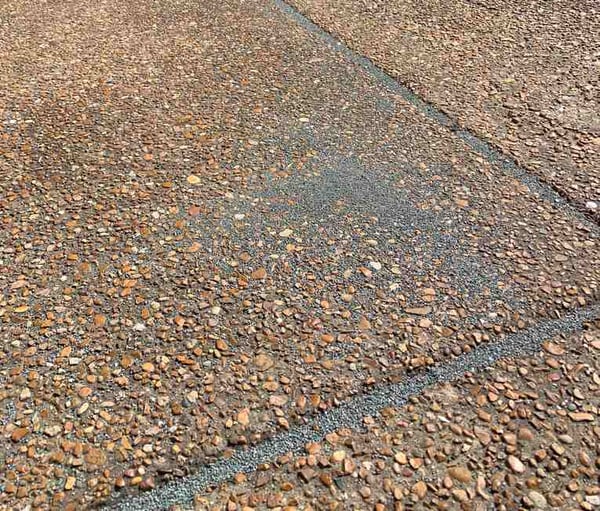
Under normal circumstances, losing granules is natural as your roof ages from wear and tear. However, hail also damages shingles enough to cause granule loss.
If this happens, you might have a viable insurance claim if you find loose granules after a big storm.
4. You see greenery growing on your roof
The next way to tell if you need a new roof is when you see greenery or other vegetation on the shingles. Moss or other vegetation growth is a sign that it’s time to start getting ready for a new roof, especially if your current one is older.
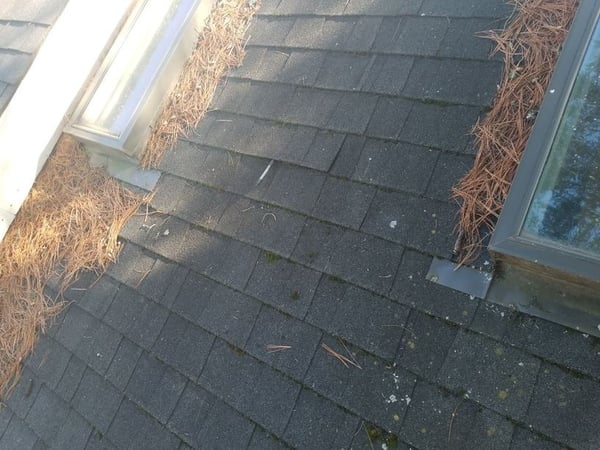 (Moss growing on architectural asphalt shingles)
(Moss growing on architectural asphalt shingles)
You’ll also probably see black algae streaks on your roof. Algae streaks form on a 10 to 15-year-old roof, but seeing them doesn’t necessarily mean you need a new roof.

It’s more of an aesthetic issue that some homeowners don’t like to see when pulling into their driveway. The great thing is that you can clean algae off your roof.
If you don’t like the black streaks, make sure to hire a professional roof cleaning company that knows how to soft wash.
5. There are dark spots on the bottom of your decking
Roof decking is the wooden foundation that your entire roof is installed on. Serious problems like mildew, mold, and structural damage come when the wooden boards rot or break.
Unfortunately, you can’t really tell if you need a new roof due to compromised decking without tearing off your old roof first. However, you can check the bottom of the decking in your attic for dark spots or discoloration to get a better idea.
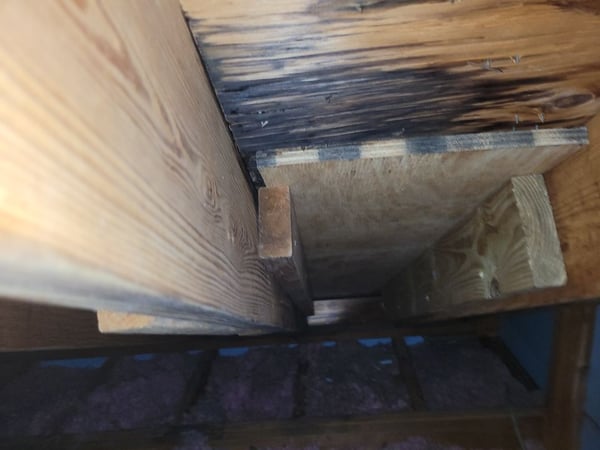
Seeing dark spots or other discoloration means water got underneath your roofing materials and soaked through the wood. This could happen from improper installation, or the roofing materials’ functionality has maxed out.
No matter the cause, finding discolored decking in your attic is a good way to tell you if you need a new roof or, at the very least, extensive and costly repairs.
6. A storm damaged your roof
I already mentioned that hail damage leads to granule loss. But another way to tell if you need a new roof is when it has storm damage from hail and/or wind.
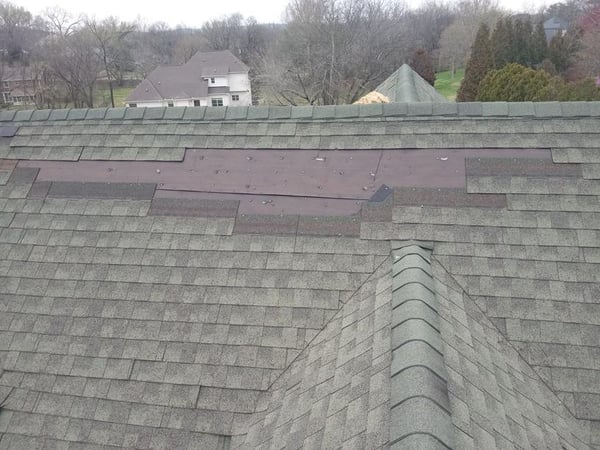
It’s easy to tell if your roof has wind damage because there will be missing shingles or whole sections off the roof. This leaves your roof decking exposed to the problems we just discussed.
In extreme circumstances, you could even have a tree or tree limbs fall on your roof from strong winds. Now, hail damage is a little tougher to spot with an untrained eye.
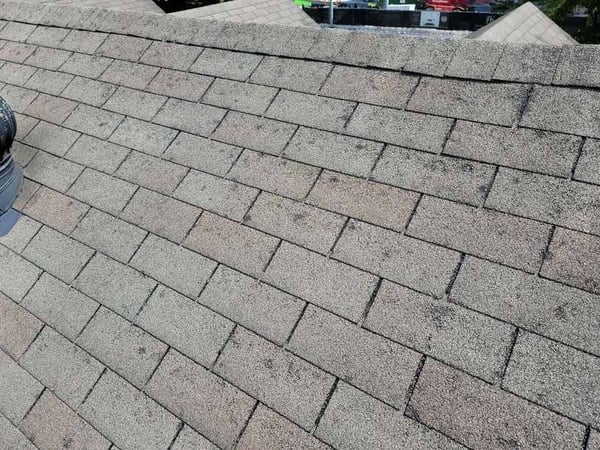
You’ll see dents or bruises large enough (around 1” in diameter) to damage the shingles if your roof has hail damage. But as I said, don’t risk your safety if you’re not 100% confident on a ladder.
Instead, you should look for collateral damage on the following things around your property:
- Dents on gutters and downspouts above 5’
- Dents or strikes on your garage door
- Holes in your window screens
- Dings to any painted wood or shutters
- Splatter marks or dings to your electric meter, AC unit, or grill
- Dents to your mailbox and other soft metals on your property
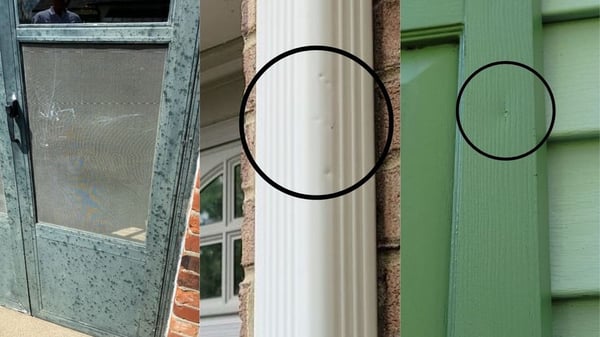
If your roof has any of the above storm damage, you’ll most likely need a new roof. Luckily, your homeowners insurance will pay for most or all of your new roof if it was damaged by extreme weather.
7. Your neighbors are getting new roofs
The last way to tell if you need a new roof is when other houses in your neighborhood are getting new roofs. You’ll definitely notice this if the homes in your neighborhood were all built around the same time.
This won’t be the case if your neighborhood is much older or the houses were built at different times. However, you should also pay attention to other homes in your neighborhood after strong storms.
If you notice multiple neighbors getting their roofs replaced after a strong thunderstorm, they most likely had a viable insurance claim. While there’s no guarantee that your roof is also damaged, you should contact a roofer and your insurance company for an assessment.
What should you consider before getting a new roof?
Now you know the 7 ways to tell if you need a new roof. Even with this list, you won’t truly know if you need a replacement until after a roof inspection.
However, looking at the areas we covered gives you a good idea if it’s time for a new roof. If it is time, you’ll need to contact a local roofing contractor to start the roof replacement process.
But just know that getting a new roof requires making some big decisions. You may think I’m overexaggerating, but your decisions greatly impact the roof you get, the final quality, and much more.
That’s why I wrote another article that gives you the main things every homeowner needs to consider when getting a new roof.
Check out The 5 Things to Consider When Replacing Your Roof to start the process of getting your new roof off on the front foot.


